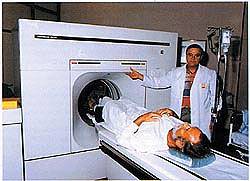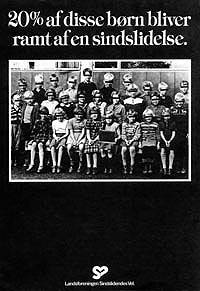
The biological perception of illness.
ICD-10
On January 1st 1994 a new international diagnostic system, called ICD-10, was introduced in Denmark.
This new system represented a break with the former view of psychiatric illnesses. From that point on mental disorders were defined solely by their appearance – by the symptoms – and not by the possible underlying contexts and causes. This makes it easier to arrive at a diagnosis of an illness because overlapping cases are limited.
The main diagnostic divisions in psychiatry, according to ICD-10, are:
F0. Organic mental disorders, here understood as illnesses or conditions caused by damage to the brain or illnesses which influence the function of the brain
F1. Abuse related mental disorders and conditions
F2. Schizophrenia, derealisation disorder, paranoid disorder, acute and transient psychotic disorder and schizoaffective disorder
F3. Affective mental disorders (mania/depression)
F4. Anxiety and stress related disorders or conditions including anxiety
F5. Behavioural changes associated with physiological disturbances and physical factors such as eating and sleep disorders and sexual disorders
F6. Disorders and changes in behaviour and personality
F7. Mental retardation
F8. Mental development disorders (including autism)
F9. Behavioural and emotional disorders developed in childhood or adolescence
From ”Psychotropic drugs ” by Jes Gerlach and Per Vestergaard, Psykiatrifonden 1998.
The letter F refers to the psychiatric diagnosis and the number refers to the division of the main diagnosis.
Psychological and theorising terms disappeared from diagnosing of mental illnesses. The psychiatric system no longer used the terms ” psychosis ”, ” neurosis ”, ” psychogenic ” , ”endogenous ” or ” psychosomatic ”. However the term ”psychotic state” is still in use today.
Symptoms which are characteristic of certain disorders can also occur in other disorders. In addition to anxiety disorders (F4), anxiety is also prevalent in organic mental disorders such as schizophrenia and depression.
Cause and Cure
Within psychology there has been a tendency, as a reaction against the use of psychotropic drugs, to find the causes of mental illnesses in the patient’s childhood and upbringing. Issues might include a tense relationship between parents, ambiguous communication or neglect.
If the child has a hereditary predisposition for what was formerly called a “frail constitution” the burden of those factors can trigger mental illness originating from a malfunction of the brain.
A predominant opinion has been that a psychological causal explanation such as this requires a cure by psychotherapeutic methods.
The following example is taken from Karin Barré’s: “Images of psychiatry – an interdisciplinary discussion and textbook” (1989):
“The violated and abused child must in his adulthood reproduce his sufferings. Another possibility is to retell his story by means of his disease. The only language and the only possibility left for this person when telling about his suffering, his pain and what he has been subjected to”.
Today, however a great deal of caution is exercised in the use of psychotherapeutic therapy, when confronting a psychotic patient with past traumas, because it can deepen the psychosis.
(For additional information, please look at poster nbr.15 regarding biological inheritance and milieu).

Brainscan at a Neurological Clinic.
1996 (Weilmünster Hospital)
Focus on the brain.
After several years of focusing on psychological, social and environmental factors when diagnosing mental illnesses, focus is now again on the brain as an ascertainable centre for both development as well as treatment of the illnesses. The biological causal explanations are to be understood as the possibility that a person can inherit a disposition for mental illness, which is looked upon as a malfunction of the brain, but it could be environmental causes that triggers the onset of the illness and also how severe it will be.
A recent twins study by the Finnish researcher Tienari, shows that psychological circumstances in an adoptive home where neither adoptive parent suffers from schizophrenia is likely to determine whether an adopted child whose biological mother suffers from schizophrenia, will or will not develop schizophrenia.
The brain is an extremely complex organ that consists of a network of nerve fibres. These nerve fibres communicate with each other via the synaptic fissures. It is here that psychotropic drugs have an effect on the processes in the brain and thereby affects the symptoms and behaviour in the patient.
More recently the discovery of a particular gene in the genome could explain the malfunction in the brain which can lead to mental illness.
Despite the last century’s major advances in academic research, it is quite a disheartening fact that the fundamental causes of mental illness are still unsolved.
Combined treatment
Today, most medical practitioners agree on treatment in which mentally ill patients should have combined treatment with both psychotherapeutic and biological elements.
„“...his practice is conducted because experience shows that although psychotropic drugs have a very significant effect on mental disorders, it has no or very poor effect on the patient’s basic personality, which on the other hand can be strengthened by psychotherapy and a social functional training...he medical treatment does not eradicate the cause of the disease as for instance seen in treatment with penicillin where inflammation is removed …”.
“.
From “Psychotropic drugs” by Jes Gerlach and Per Vestergaard, Psykiatrifonden 1998
Today, it is known that patients suffering from schizophrenia who were formerly treated only with psychotropic drugs also might benefit from cognitive treatment.
Biological treatment
Throughout the 1970s and 1980s, the biological treatment of mental illness was criticised by amongst others Galebevægelsen (The Mad Movement). They were of the opinion that medication was used too often and not enough consideration was given to the psychological and social factors of the illness.
The pharmaceutical industry used, as formulated in the jargon of the anti-psychiatry movement of the time,”... extensive propaganda aimed at doctors and psychiatrists...”, and they were in charge of “...the chemical development of drugs...”“...laboratory testing on animals, while it was the psychiatrists who tried the medication on patients in mental hospitals...”
From “Galskab, psykiatri, galebevægelse” (Madness, psychiatry, Mad Movement) by Anders Kelstrup, Galebevægelsen.(The Mad Movement 1983)
This criticism has virtually disappeared during the 1990s.
The incidence of mental disorders
In the course of a year it is estimated that 30% of the adult population in Denmark will experience psychological symptoms. Of the adult population it is thought that 10% need professional help. This corresponds to 400,000 people
30-40.000 patients are being treated by practicing psychiatrists, 63.000 are treated in mental hospitals, psychiatric outpatient clinics and the district psychiatry service. This leaves a very large group of patients who are not getting the professional help they could benefit from.
Depression is the most widely occurring of mental disorders. 200.000 adults are believed to suffer from depression. Anxiety is also prevalent – approx. 50.000 adults are troubled by anxiety attacks. 40.000 are suffering from psychosis, 30.000 are suffering from a bipolar disorder and 18.000 are suffering from schizophrenia. Half of all patients suffering from depression never get the treatment that could help them.
5-7 % of the population over 65 years old suffer from dementia – and the number rises sharply the older the person gets.
The above figures come from an interview with Head Psychiatrist Povl Munk-Jørgensen from Department of Psychiatric Demography. It was published in the magazine “Samvirke” in the November edition 1998 with the title “The pain which is kept in silence”.



